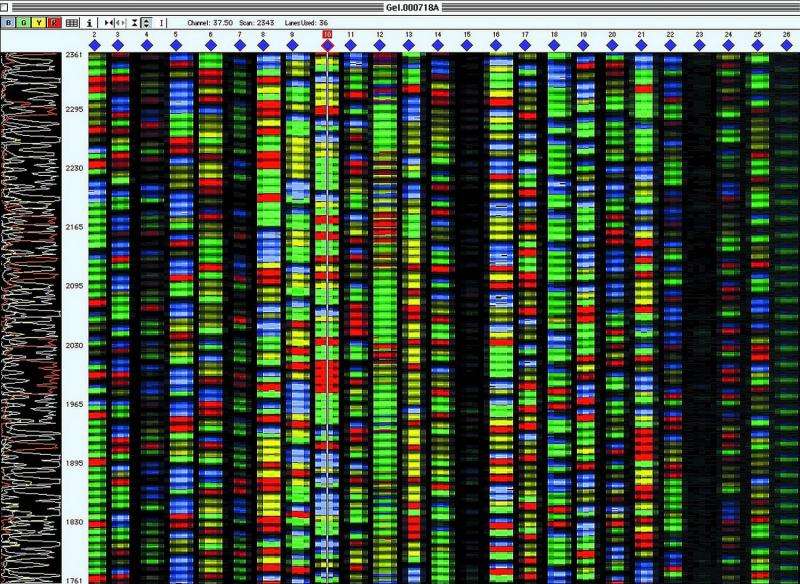'Measuring stick' standard for gene sequencing now available from NIST

The world's first reference material to help ensure laboratories accurately "map" DNA for genetic testing, medical diagnoses and future customized drug therapies is now available from the National Institute of Standards and Technology (NIST).
The new reference material, NIST RM 8398, is a "measuring stick" for the human genome, the coded blueprints of a person's genetic traits. It provides a well-characterized standard that can tell a laboratory how well its processes for determining the patterns in a person's DNA (called DNA or gene sequencing) are working by measuring the performance of the equipment, chemistry and data analysis involved.
NIST RM 8398 was created by NIST and its partners in the Genome in a Bottle consortium, a group that includes stakeholders from industry, academia and the federal government. Scientists from NIST and the U.S. Food and Drug Administration (FDA) helped organize the collaborative effort to provide the technical benchmarks (reference standards, reference methods and reference data) needed to enable widespread clinical applications of whole genome sequencing and science-based regulatory oversight of the technology by the FDA.
In fact, the prototype version of NIST RM 8398 has already been on the job. In November 2013, the FDA used the genome created during the reference material's development phase to certify and approve one of the first commercially available high-throughput DNA sequencers.
The new reference material marks a significant step forward in addressing FDA's regulatory needs for evaluating next-generation gene sequencing and genetic testing as outlined in President Barack Obama's Precision Medicine (also known as "personalized medicine") initiative.
DNA sequencers take long strings of a person's DNA and randomly chop them into small pieces that can be individually analyzed to determine their sequence of letters from the genetic code (A, C, G and T representing the four key components of DNA that code for protein production in living organisms: adenine, cytosine, guanine and thymine). The sequenced pieces can then be compared to a defined "reference sequence" to identify differences in the two codes. The differences reveal where mutations have occurred in specific genes.
However, biases and "blind spots" for certain sequences contribute to uncertainties or errors in the sequence analysis. These biases can lead to hundreds of thousands of disagreements between different sequencing results for the same human genome.
Laboratories can now use the DNA in NIST RM 8398 (taken from a cell line—referred to as NA12878—of an individual whose genome was acquired in a 1980s research study) to identify these biases. Using the new NIST standard as a benchmark, DNA sequencing laboratories can be more confident in their reporting of true positives, false positives, true negatives and false negatives.
The reference material is the first complete human genome to have been extensively sequenced and re-sequenced by multiple techniques, with the results weighted and analyzed to eliminate as much variation and error as possible.
The method used to create NIST RM 8398, as well as the findings validating the tool, may be found in a March 2014 Nature Biotechnology paper as well as on the Genome in a Bottle website. In addition, the Genome Comparison and Analytic Testing, or GCAT, website enables real-time benchmarking of any DNA sequencing method using these results.
The Genome in a Bottle consortium is currently developing well-characterized whole genome reference materials from two genetically diverse groups: Asians and Ashkenazi Jews. Both of the future reference materials will include sequenced genes from father-mother-child "trios" to utilize genetic links between family members.
NIST RM 8398, Human DNA for Whole-Genome Variant Assessment (Daughter of Utah/European Ancestry), is available in vials each containing 10 micrograms of genomic NA12878 DNA. All samples of the reference material have been characterized for homogeneity (ensuring that each vial contains similar DNA) and stability (ensuring that the DNA ordered now will be comparable to samples ordered in the future).
NIST RM 8398 is available from the NIST Standard Reference Materials Program.
More information: J.M. Zook, B. Chapman, J. Wang, D. Mittelman, O. Hofmann, W. Hide and M. Salit. Integrating human sequence data sets provides a resource of benchmark SNP and indel genotype calls. Nature Biotechnology (March 2014). DOI: 10.1038/nbt.2835
Journal information: Nature Biotechnology
Provided by National Institute of Standards and Technology


















